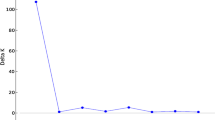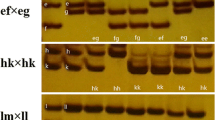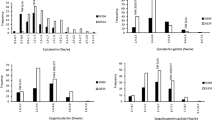Abstract
Tea plant (Camellia sinensis) is a major beverage crop across the world. To uncover the genetic controls of agronomic traits and facilitate marker-assisted breeding (MAB) in tea plant, we constructed a saturated SSR-based linkage map using an F1 population derived from the crossing of ‘Longjin43’ × ‘Baihaozao’. A total of 483 SSR markers, consisting of 117 novel loci, 129 transferred from other tea plant maps, and 237 previously mapped, were successfully integrated into a new consensus map. The map has 15 linkage groups, covering 1226.2 cM in total with an average marker distance of 2.5 cM. The 126 markers in common enabled us to align this map to the reference genetic maps of tea plant. Phenotype data were collected in 2014 and 2015 for five traits: timing of spring bud flush (TBF), young shoot color (YSC), mature leaf length (MLL), mature leaf width (MLW), and leaf shape index (LSI, i.e., MLL/MLW). QTL analyses were performed for the five traits using the new consensus map and 15 QTLs were identified. The SSR markers, linkage map, and QTLs reported here are useful resources for future QTL mining, identification of causal genes, and MAB in tea plant.




Similar content being viewed by others
References
Albert NW, Davies KM, Lewis DH, Zhang H, Montefiori M, Brendolise C, Boase MR, Ngo H, Jameson PE, Schwinn KE (2014) A conserved network of transcriptional activators and repressors regulates anthocyanin pigmentation in eudicots. Plant Cell 26:962–980
Azuma A, Yakushiji H, Koshita Y, Kobayashi S (2012) Flavonoid biosynthesis-related genes in grape skin are differentially regulated by temperature and light conditions. Planta 236(4):1067–1080
Bali S, Mamgain A, Raina SN, Yadava SK, Bhat V, Das S, Pradhan AK, Goel S (2015) Construction of a genetic linkage map and mapping of drought tolerance trait in Indian beveragial tea. Mol Breeding 35:112
Bushakra JM, Krieger C, Deng D, Stephens MJ, Allan AC, Storey R, Symonds VV, Stevenson D, McGhie T, Chagné D, Buck EJ, Gardiner SE (2013) QTL involved in the modification of cyanidin compounds in black and red raspberry fruit. Theor Appl Genet 126:847–865
Castro AJ, Capettini F, Corey AE, Filichkin T, Hayes PM, Kleinhofs A, Kudrna D, Richardson K, Sandoval-Islas S, Rossi C, Vivar H (2003) Mapping and pyramiding of qualitative and quantitative resistance to stripe rust in barley. Theor Appl Genet 107:922–930
Chen L, Zhou ZX, Yang YJ (2007) Genetic improvement and breeding of tea plant (Camellia sinensis) in China: from individual selection to hybridization and molecular breeding. Euphytica 154:239–248
Collard BCY, Mackill DJ (2008) Marker-assisted selection: an approach for precision plant breeding in the twenty-first century. Philos TR Soc B 363:557–572
Darvasi A, Weinreb A, Minke V, Weller JI, Soller M (1993) Detecting marker-QTL linkage and estimating QTL gene effect and map location using a saturated genetic map. Genetics 134:943–951
Derory J, Scotti-Saintagne C, Bertocchi E, Dantec LL, Graignic N, Jauffres A, Casasoli M, Chancerel E, Bodénès C, Alberto F, Kremer A (2010) Contrasting relationships between the diversity of candidate genes and variation of bud burst in natural and segregating populations of European oaks. Heredity 104:438–448
Devi AM, Goel S, Misra A (2015) Generation of silver stained TE-AFLP markers in tea (Camellia sinensis) and their assessment in filling gaps with construction of a genetic linkage map. Sci Hortic 192:293–301
Ellis JR, Burke JM (2007) EST-SSRs as a resource for population genetic analyses. Heredity 99:125–132
Flachowsky H, Le Roux PM, Peil A, Patocchi A, Richter K, Hanke MV (2011) Application of a high‐speed breeding technology to apple (Malus × domestica) based on transgenic early flowering plants and marker‐assisted selection. New Phytol 192:364–377
Frewen BE, Chen THH, Howe GT, Davis J, Rohde A, Boerjan W, Bradshaw HDJ (2000) Quantitative trait loci and candidate gene mapping of bud set and bud flush in Populus. Genetics 154:837–845
Fournier-Level A, Cunff LL, Gomez C, Doligez A, Ageorges A, Roux C, Bertrand Y, Souquet JM, Cheynier V, This P (2009) Quantitative genetic bases of anthocyanin variation in grape (Vitis vinifera L. ssp. sativa) berry: a quantitative trait locus to quantitative trait nucleotide integrated study. Genetics 183:1127–1139
Gailing O (2008) QTL analysis of leaf morphological characters in a Quercus robur full-sib family (Q. robur × Q. robur ssp. slavonica). Plant Biol 10:624–634
Gupta PK, Langridge P, Mir RR (2010) Marker-assisted wheat breeding: present status and future possibilities. Mol Breeding 26:145–161
Hackett CA, Wachira FN, Paul S, Powell W, Waugh R (2000) Construction of a genetic linkage map for Camellia sinensis (tea). Heredity 85:346–355
Hajra NG, Yang CWM (2015) Diversification of the tea products—global scenario. J Tea Sci Res 5(3):1–12
Hayat K, Iqbal H, Malik U, Bilal U, Mushtaq S (2015) Tea and its consumption: benefits and risks. Crit Rev Food Sci Nutr 55(7):939–954
Hichri I, Barrieu F, Bogs J, Kappel C, Delrot S, Lauvergeat V (2011) Recent advances in the transcriptional regulation of the flavonoid biosynthetic pathway. J Exp Bot 62:2465–2483
Hu CY, Lee TC, Tsai HT, Tsai YZ, Lin SF (2013) Construction of an integrated genetic map based on maternal and paternal lineages of tea (Camellia sinensis). Euphytica 191:141–152
Huang FP, Liang YR, Lu JL, Chen RB (2006) Genetic mapping of first generation of backcross in tea by RAPD and ISSR markers. J Tea Sci 26:171–176
Huang JA, Li JX, Huang YH, Luo JW, Gong ZH, Liu ZH (2005) Construction of AFLP molecular markers linkage map in tea plant. J Tea Sci 25:7–15
Jermstad KD, Bassoni DL, Jech KS, Wheeler NC, Neale DB (2001) Mapping of quantitative trait loci controlling adaptive traits in coastal Douglas-fir. I. Timing of vegetative bud flush. Treor Appl Genet 102:1142–1151
Jiang L, Shen X, Shoji T, Kanda T, Zhou J, Zhao L (2013) Characterization and activity of anthocyanins in Zijuan tea (Camellia sinensis var. kitamura). J Agric Food Chem 61:3306–3310
Kamunya SM, Wachira FN, Pathak RS, Korir R, Sharma V, Kumar R, Bhardwaj P, Chalo R, Ahuja PS, Sharma RK (2010) Genomic mapping and testing for quantitative trait loci in tea (Camellia sinensis (L.) O. Kuntze). Tree Genet Genomes 6:915–929
Khan N, Mukhtar H (2013) Tea and health: studies in humans. Curr Pharm Des 12:6141–6147
Knox MR, Ellis THN (2002) Excess heterozygosity contributes to genetic map expansion in pea recombinant inbred populations. Genetics 162:861–873
Li X, Wang X, Wei Y, Brummer EC (2011) Prevalence of segregation distortion in diploid alfalfa and its implications for genetics and breeding applications. Theor Appl Genet 123:667–679
Liang YR, Shi M (2015) Advances in tea plant genetics and breeding. J Tea Sci 35:103–109
Lowe KM, Riaz S, Walker MA (2009) Variation in recombination rates across Vitis species. Tree Genet Genomes 5:71–80
Luo YP (2015) The cultivation of tea plant. China Agriculture Press, Beijing
Ma JQ, Huang L, Ma CL, Jin JQ, Li CF, Wang RK, Zheng HK, Yao MZ, Chen L (2015) Large-scale SNP discovery and genotyping for constructing a high-density genetic map of tea plant using specific-locus amplified fragment sequencing (SLAF-seq). PLoS ONE 10, e0128798
Ma JQ, Yao MZ, Ma CL, Wang XC, Jin JQ, Wang XM, Chen L (2014) Construction of a SSR-based genetic map and identification of QTLs for catechins content in tea plant (Camellia sinensis). PLoS ONE 9, e93131
Mondal TK (2009) Tea breeding. Breeding plantation tree crops: tropical species. Springer, New York, pp 545–587
Mori K, Goto-Yamamoto N, Kitayama M, Hashizume K (2007) Loss of anthocyanins in red-wine grape under high temperature. J Exp Bot 58(8):1935–1945
Pojer E, Mattivi F, Johnson D, Stockley CS (2013) The case for anthocyanin consumption to promote human health: a review. Compr Rev Food Sci F 12:483–508
Pompanon F, Bonin A, Bellemain E, Taberlet P (2005) Genotyping errors: causes, consequences and solutions. Nat Rev Genet 6:847–846
R Development Core Team (2009) R: a language and environment for statistical computing. R Foundation for Statistical Computing, Vienna
Saito T, Honma D, Tagashira M, Kanda T, Nesumi A, Maeda-Yamamoto M (2011) Anthocyanins from new red leaf tea ‘Sunrouge’. J Agric Food Chem 59:4779–4782
Stange M, Utz HF, Schrag TA, Melchinger AE, Würschum T (2013) High-density genotyping: an overkill for QTL mapping? Lessons learned from a case study in maize and simulations. Theor Appl Genet 126:2563–2574
Tan LQ, Peng M, Xu LY, Wang LY, Chen SX, Zou Y, Qi GN, Cheng H (2015) Fingerprinting 128 Chinese clonal tea cultivars using SSR markers provides new insights into their pedigree relationships. Tree Genet Genomes 11:1–12
Tan LQ, Wang LY, Wei K, Zhang CC, Wu LY, Qi GN, Cheng H, Zhang Q, Cui QM, Liang JB (2013) Floral transcriptome sequencing for SSR marker development and linkage map construction in the tea plant (Camellia sinensis). Plos One 8, e81611
Tanaka J, Taniguchi F, Hirai N, Yamaguchi S (2006) Estimation of the genome size of tea (Camellia sinensis), camellia (C. japonica), and their interspecific hybrids by flow cytometry. Tea Res J 101:1–7
Taniguchi F, Furukawa K, Ota-Metoku S, Yamaguchi N, Ujihara T, Kono I, Fukuoka H, Tanaka J (2012) Construction of a high-density reference linkage map of tea (Camellia sinensis). Breed Sci 62:263–273
Tsarouhas V, Gullberg U, Lagercrantz U (2003) Mapping of quantitative trait loci controlling timing of bud flush in Salix. Hereditas 138:172–178
Ubi BE, Honda C, Bessho H, Kondo S, Wada M, Kobayashi S, Moriguchi T (2006) Expression analysis of anthocyanin biosynthetic genes in apple skin: effect of UV-B and temperature. Plant Sci 170(3):571–578
UPOV (International Union for the Protection of New Varieties of Plants) (2008) Guidelines for guidelines for the conduct of tests for distinctness, uniformity and stability (tea). UPOV, Geneva
Van Ooijen JW (2004) MapQTL5, software for the mapping of quantitative trait loci in experimental populations. Kyazma BV, Wageningen
Van Ooijen JW (2006) JoinMap 4. Software for the calculation of genetic linkage maps in experimental populations. Kyazma BV, Wageningen
Voorrips RE (2002) MapChart: software for the graphical presentation of linkage maps and QTLs. J Hered 93:77–78
Vuong QV, Stathopoulos CE, Nguyen MH, Golding JB, Roach PD (2011) Isolation of green tea catechins and their utilization in the food industry. Food Rev Int 27:227–247
Wang L, Wang Y, Cao H, Hao X, Zeng J, Yang Y, Wang X (2016) Transcriptome analysis of anthracnose-resistant tea plant cultivar reveals genes associated with resistance to Colletotrichum camelliae. PLoS ONE 11, e0148535
Wang QP, Peng CX, Gao B, Gong JS (2012) Influence of large molecular polymeric pigments isolated from fermented Zijuan tea on the activity of key enzymes involved in lipid metabolism in rat. Exp Gerontol 47:672–679
Wang X, Hao X, Ma C, Cao H, Yue C, Wang L, Zeng J, Yang Y (2014) Identification of differential gene expression profiles between winter dormant and sprouting axillary buds in tea plant (Camellia sinensis) by suppression subtractive hybridization. Tree Genet Genomes 10:1149–1159
Welter LJ, Göktürk-Baydar N, Akkurt M, Maul E, Eibach R, Töpfer R, Zyprian EM (2007) Genetic mapping and localization of quantitative trait loci affecting fungal disease resistance and leaf morphology in grapevine (Vitis vinifera L). Mol Breeding 20:359–374
Wu HL, He YM, Li JX, Chen D, Huang HL, Qian XY, Liu J (2012) Shoot traits and biological copositions among eleven new tea germplasms with reddishviolet shoots. J Plant Genet Resour 13(1):42–47
Xu S (2008) Quantitative trait locus mapping can benefit from segregation distortion. Genetics 180(4):2201–2208
Yang CS, Wang X, Lu G, Picinich SC (2009) Cancer prevention by tea: animal studies, molecular mechanisms and human relevance. Nat Rev Cancer 9:429–439
Yang YJ, Liang YR (2014) Clonal tea cultivars in China. Shanghai Scientific and Technical Publishers, Shanghai
Yao MZ, Ma CL, Qiao TT, Jin JQ, Chen L (2012) Diversity distribution and population structure of tea germplasms in China revealed by EST-SSR markers. Tree Genet Genomes 8:205–220
Yousef GG, Juvik JA (2001) Comparison of phenotypic and marker-assisted selection for quantitative traits in sweet corn. Crop Sci 41:645–655
Zhang L, Wang S, Li H, Deng Q, Zheng A, Li S, Li P, Li Z, Wang J (2010) Effects of missing markers and segregation distortion on QTL mapping in F2 populations. Theor Appl Genet 121:1071–1082
Zhu C, Wang C, Zhang Y (2007) Modeling segregation distortion for viability selection. I. Reconstruction of linkage maps with distorted markers. Theor Appl Genet 114:295–305
Acknowledgments
We would like to give special thanks to Prof. Shunyuan Xiao from the University of Maryland and the anonymous reviewers for their constructive comments on the manuscript. This work was supported by The Earmarked Fund for Modern Agro-industry Technology Research System (nycytx-23) and the Twelfth Five-Year Project of Sichuan Province for Tea Plant Breeding, Science and Technology Department Project of Sichuan Province (2012-12CGZHZX0579).
Data archiving statement
We followed standard Tree Genetics and Genomes policy. The primer sequences and marker positions on the consensus map are provided in Online Resource 1. The genotype and phenotype data are provided in Online Resources 2 and 6, respectively.
Author information
Authors and Affiliations
Corresponding authors
Additional information
Communicated by Z. Kaya
Li-Qiang Tan and Li-Yuan Wang contributed equally to this work.
Electronic supplementary material
Below is the link to the electronic supplementary material.
Online Resource 1
Positions and primer sequences of the SSR markers on the consensus map. (PDF 60.3 kb)
Online Resource 2
(XLSX 365 kb)
Online Resource 3
(JPG 714 kb)
Online Resource 4
(JPG 381 kb)
Online Resource 5
Allelic and zygotic segregation distortion test results in the ‘L43’ × ‘BHZ’ population. (XLSX 13.6 kb)
Online Resource 6
(XLSX 34.5 kb)
Rights and permissions
About this article
Cite this article
Tan, LQ., Wang, LY., Xu, LY. et al. SSR-based genetic mapping and QTL analysis for timing of spring bud flush, young shoot color, and mature leaf size in tea plant (Camellia sinensis). Tree Genetics & Genomes 12, 52 (2016). https://doi.org/10.1007/s11295-016-1008-9
Received:
Revised:
Accepted:
Published:
DOI: https://doi.org/10.1007/s11295-016-1008-9




